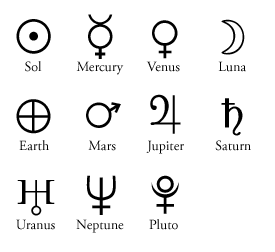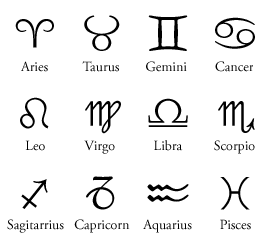Components of Astrology
(Difference between revisions)
Categories: Astrology | Astrological terms
|
Revision as of 06:46, 23 Jun 2013 Capella (Talk | contribs) Glyphs |
Revision as of 06:47, 23 Jun 2013 Capella (Talk | contribs) Glyphs |
||
| Line 15: | Line 15: | ||
| *'''Circle''' - Soul (Sulfur) | *'''Circle''' - Soul (Sulfur) | ||
| - | Note: The Cross is also referred to as 'the Point in Extension' | + | ''Note: The Cross is also referred to as 'the Point in Extension' and sometimes as a Square.'' |
| Planet - [Glyph] - Meaning - (Alchemical Phase, Step, Metal) | Planet - [Glyph] - Meaning - (Alchemical Phase, Step, Metal) | ||
Revision as of 06:47, 23 Jun 2013
 |
This article is incomplete. You can help Thelemapedia by adding to it (http://thelemapedia.org/index.php?title=Components_of_Astrology&action=edit). |
Unlike the daily horoscope in the newspaper, the many astrological components form a complex system. They fall under the general categories of heavenly bodies, the Zodiac, houses, aspects, motion, and interpretation.
A brief discussion on how the various astrological components work together...
| Table of contents |
Heavenly bodies
Glyphs
Symbol - Meaning (Alchemical)
- Cross - Matter (Salt)
- Crescent - Mind/Spirit (Mercury)
- Circle - Soul (Sulfur)
Note: The Cross is also referred to as 'the Point in Extension' and sometimes as a Square.
Planet - [Glyph] - Meaning - (Alchemical Phase, Step, Metal)
- Saturn - [Cross over Crescent] - Conscious or Ego - (Nigredo, Calcination, Lead)
- Jupiter - [Crescent over Cross] - Subconscious - (Nigredo, Dissolution, Tin)
- Mars - [Cross over Circle] - Removing the Unwanted and Uncovering the Essence - (Albedo, Separation, Iron)
- Venus - [Circle over Cross] - Ensouling the Spirit - (Albedo, Conjunction, Copper)
- Mercury - [Crescent over Circle over Cross] - Enlivening - (Rubedo, Fermentation, Quicksilver)
- Moon - [Double Crescent] - Boiling Down to Essence - (Rubedo, Distillation, Silver)
- Sun - [Circle and Point] - Incarnation - (Rubedo, Coagulation, Gold)
Planets
The Sun is the head of the '7 Governors of the Ancient Astrology' with the 3 outer planets (non-naked eye planets) considered 'higher octaves' of 3 of the governors. Note: Modern astrology is more inclusive of the outer planets.
- Sun—the inner core of a person or situation, the deepest self and influential power.
- Mercury—reason, intelligence; writing, orderliness, education, skill.
- Venus—beauty, allure, pleasure, relationships and eroticism.
- Luna—feelings and emotions; illusion; imagination.
- Mars—action, spontaneity, aggression, and drive.
- Jupiter—expansiveness and growth; justice, fortune.
- Saturn—discipline, responsibility, limitations, and resistance; law and order; caution and reserve.
- Uranus—technology, the future, science, innovation, radical change, the unexpected.
- Neptune—inspiration, spirituality, magick, enchantment, dreams, altered states.
- Pluto—power, metamorphosis, change and rebirth, cycles of dying and becoming.
Octaves
- Uranus is the higher Octave of Mercury
- Neptune is the higher Octave of Venus
- Pluto is the higher Octave of Mars
Asteroids
Other
[See Arabic Parts from author Abu Rayhan al-Biruni]
Moons
[See Mansions of the Moon - The Three Books of Occult Philosophy by Henry Cornelius Agrippa]
The Zodiac
The Zodiac refers to the twelve constellations that fall on the plane of the ecliptic (the path the sun takes across the sky over the course of the year). They are a combination of 4 elements x 3 modalities (Cardinal: start, Fixed: maintain, Mutable: complete). And they are the manifestations (forms) of the planets (force). [Also see the 12 hours of Apollonius (Apollonius of Tyana aka Balinus. The '12 Hours' possibly published within his works 'Secret of Creation' or 'Liber de Causis') and the '12 Labours of Herakles' by Alice A. Bailey]
The following is a general description of their characteristics:
- Aries—"I want," action oriented, pioneering, assertive, enthusiasm, competitive (Cardinal Fire)
- Taurus—"I have," sensual, cautious, stubborn, physical (Fixed Earth)
- Gemini—"I think," curious, talkative, sociable, duality, mercurial, intelligent (Mutable Air)
- Cancer—"I feel," sensitive, tenacious, family and home oriented, helpful, nurturing, moody (Cardinal Water)
- Leo— "I am," passionate, dramatic, independent, noble, leader, egotistical, selfish (Fixed Fire)
- Virgo—"I serve," practical, analytical, work and service oriented, critical, common sense, orderly (Mutable Earth)
- Libra—"We are," partnerships, balance, grace, charm, cooperative, social, ideas, lazy, kidneys/lumbar (Cardinal Air)
- Scorpio—"I desire," intense, controlling, sexual, compulsive, deep, secretive, mysterious, obsessive (Fixed Water)
- Sagittarius—"I seek," philosophic, fun-loving, adventurous, blundering, wanderlust, scattered (Mutable Fire)
- Capricorn—"I build," ambitious, cautious, authoritative, cunning, competent, stable, saturnine (Cardinal Earth)
- Aquarius—"I know," friendships, cause-oriented, the group, society, progressive, eccentric, aloof (Fixed Air)
- Pisces—"I believe," feeling, duality, spirituality, soul growth, suffering, artistic, overly emotional (Mutable Water)
Houses
Most astrological systems divide the astrological chart (or natal chart) into twelve houses, which depend more on the time and place of birth (or initiation) than on the date. To calculate the houses of a chart it is necessary to know the exact time of birth. If the time of birth is unknown some astrologers will assume a birth at noon or sunrise, but an meaningful interpretation of such a chart cannot be expected.
There are many ways to divide the ecliptic into twelve houses. The main House systems are: Placidus (the most common), Equal, Whole, Regiomontanus, Meridian, Campanus, Porphyry, Koch, Topocentric.
The houses are departments of life, described in terms of man's physical surroundings as well as personal life experiences, and in modern astrology have some correspondence with their natural sign, i.e. the first house has a natural affinity with the first sign, Aries, and so on. (However the latter is not true in ancient astrology* where the rulership of select Houses is held by the Planetary Joys also known as the Joys of the Houses**, not the Zodiac.)
The following is a general description of their characteristics:
- First house: (Self) Identity, self-image, movement and expression, physical appearance, and the impact of the personality on the environment. This is the way you present yourself, and how you start things. Planets here may also indicate the manner of one's birth.
- Second house: (Resources) Values, substance, money, possessions, security, stability, the here and now, sense of self-worth, emotional resources, rewards, comfort, inner talents and resources. Also "Gate from Hades" (opposite 8th House) surfacing with gems from the earth. House of Typhon. Profession of Children (10th from 5th)
- Third house: (Short Journies, Siblings, Car) Habits. awareness, mental expression, early schooling, siblings, attitudes, daily life, companions, all forms of communication and short journeys, adaptability to new ideas, ability to relate to one's surroundings and environment.
- Fourth house: (Home, Father) foundations, inheritance, domestic matters, heritage, roots, and sources of nourishment.
- Fifth house: (Love Affairs, Children) Pregnancy, anything added or taken away from the fourth house, ego, creative expression, play, sports, gambling, attitude to change.
- Sixth house: (Daily Toil, Health/Illness, Pets) Housework, employment and employees, attitude to work, general health, purification, ritual, habits, hobbies.
- Seventh house: (Marriage and Partnerships) "The Other", awareness of others, how one relates to people.
- Eighth house: (Death, Taxes, Other People's Money), Loss, Resources of the 7th house, "Gate of Hades", Joint or shared resources, sex, regeneration, emotional union.
- Ninth house: (Long Journies, House of God) Travel, religion, search for meaning, higher education, goals and aspirations, seeking and finding. Things which take a long time to achieve.
- Tenth house: (Career, Fame and Honors, Mother) Public image, profession, persona, reputation, values and standards, ideals, how one would like to project oneself.
- Eleventh house: (Friends and Organizations) Those from which the fame and honors of the 10th are founded, social values and concerns, groups and group awareness, hopes and dreams, attitude to humanity.
- Twelfth house: (Mystery, Mysticism, Self-Undoing, Institutions) Hidden motives, confinement, retreat, self-transcendence, service and sacrifice, karma, escapism, charity. Hospitals, Prisons.
(*)Footnote: The house system developed with the Greeks and added a separate context layer attributed to the area of ones life on top of an already developed zodiacal and planetary system rooted in Egypt and Babylon.
(**)Footnote: Joys of the Houses: 1st=Mercury, 3rd=Moon, 5th=Venus, 6th=Mars, 9th=Sun, 11th=Jupiter, 12th=Saturn
Aspects
The angular relationships between the planets as they actually exist in space are termed “aspects”. These aspects are believed to influence the nature of the planets and how they work together. The aspects are the 'conversations' of the planets. The following is a general description of the major aspects:
- Conjunction (0°)—Harmonious
- Opposition (180°)—Disharmonious (not necessarily negative); also energizing
- Square (90°)—Disharmonious and blocked
- Trine (120°)—Harmonious & complementary
- Sextile (60°)—Moderately harmonious
More aspects...
Orbs
Motion
Retrograde
Transits
Returns
Processions
Equinoxes & Solstices
Interpretation
Natal charts
Other charts. Methods of interpretation.
![[Main Page]](http://www.thelemapedia.org/images/logo.gif)

